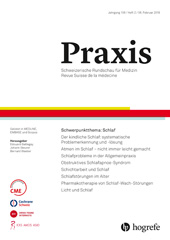Obstruktives Schlafapnoe-Syndrom
Abstract
Zusammenfassung. Das obstruktive Schlafapnoe-Syndrom (OSAS) ist eine Atemregulationsstörung, bei der ein repetitiver Kollaps der oberen Atemwege während des Schlafes zu gehäuften Apnoen/Hypopnoen mit zyklischen Sauerstoffdesaturationen und Weckreaktionen führt. Der Schlaf wird dadurch fragmentiert und ist nicht erholsam. Die betroffenen Patienten leiden unter vermehrter Einschlaftendenz, Konzentrationsstörungen und einer beeinträchtigten Lebensqualität. Zu den Folgen des OSAS gehören zudem ein erhöhtes Risiko, Unfälle durch Einschlafen zu verursachen, sowie Herz- und Kreislauferkrankungen. Die Diagnose des OSAS beruht auf einer typischen Anamnese und der klinischen Untersuchung. Übergewicht, ein grosser Halsumfang und enge Rachenverhältnisse können auf ein OSAS hinweisen. Die Diagnose wird durch eine Schlafuntersuchung bestätigt. Die wichtigste Behandlung des OSAS ist die nächtliche Anwendung von kontinuierlichem Überdruck (CPAP) über eine Nasen- oder Mund-Nasen-Maske, was in der Regel zur raschen Besserung der Symptome führt. Patienten, die eine CPAP-Therapie nicht tolerieren, können mit einer Unterkieferprotrusionsschiene erfolgreich behandelt werden. Unterstützende Massnahmen sind regelmässige und genügend lange Schlafzeiten, das Vermeiden von Rauchen und abendlichem Alkoholkonsum und die Gewichtsreduktion bei Adipositas.
Abstract. The obstructive sleep apnea syndrome (OSAS) is a disorder of the control of breathing in which repetitive collapse of the upper airway during sleep leads to frequent apneas/hypopneas with cyclic oxygen desaturation and arousals. Sleep is fragmented and unrefreshing. The affected patients suffer from an increased tendency to fall asleep, impaired concentration and a reduced quality of life. The consequences of OSAS also include an increased risk of accidents caused by falling asleep as well as cardiovascular diseases. The diagnosis of OSAS is based on a typical history and clinical examination. Overweight, a large neck circumference and a narrow throat are conditions that may suggest an OSAS. The diagnosis is confirmed by sleep examination. The most important treatment for OSAS is the nightly application of continuous positive pressure (CPAP) via a nasal or mouth-nose mask, which usually leads to a rapid improvement of the symptoms. Patients who do not tolerate CPAP therapy can be successfully treated with a mandibular advancement device. Supporting measures are regular and sufficiently long sleeping times, avoidance of smoking and alcohol consumption in the evening as well as weight reduction for obese patients.
Résumé. Le syndrome d’apnées obstructives du sommeil (SAOS) est un trouble de la régulation respiratoire dans lequel l’affaissement répétitif des voies respiratoires supérieures pendant le sommeil entraîne une accumulation d’apnées/hypopnées avec désaturation cyclique en oxygène et réactions de réveil. Le sommeil est fragmenté et non réparateur. Les patients atteints souffrent d’une tendance accrue à s’endormir, de troubles de la concentration et d’une qualité de vie altérée. Les conséquences du SAOS comprennent également un risque accru d’accidents causés par l’endormissement et de maladies cardiovasculaires. Le diagnostic de SAOS est basé sur une anamnèse typique et un examen clinique. Un excès de poids, une circonférence du cou importante et une gorge serrée peuvent indiquer la présence d’un SAOS. Le diagnostic est confirmé par un test du sommeil. Le traitement le plus important du SAOS est l’application nocturne d’une pression positive continue (PPC) au moyen d’un masque nasal ou oro-nasal, qui entraîne habituellement une amélioration rapide des symptômes. Les patients qui ne tolèrent pas le traitement par PPC peuvent être traités avec succès au moyen d’une attelle de protrusion mandibulaire. Les mesures de soutien sont des périodes de sommeil régulières et suffisamment longues, éviter de fumer et de consommer de l’alcool le soir et, en cas d’obésité, de perdre du poids.
Bibliografie
: Pathophysiology of sleep apnea.
Physiol Rev 2010; 90: 47–112.: Obstructive sleep apnoea and cardiovascular disease.
Lancet Respir Med 2013; 1: 61–72.: Day-night pattern of sudden death in obstructive sleep apnea.
N Engl J Med 2005; 352: 1206–1214.: Reduction in motor vehicle collisions following treatment of sleep apnoea with nasal CPAP.
Thorax 2001; 56: 508–512., : Prevalence of sleep-disordered breathing in the general population: the HypnoLaus study.
Lancet Respir Med 2015; 3: 310–318., : The occurrence of sleep-disordered breathing among middle-aged adults.
N Engl J Med 1993; 328: 1230–1235.: German version of the Epworth Sleepiness Scale.
Respiration 1999; 66: 440–447.: Does this patient have obstructive sleep apnea? The rational clinical examination systematic review.
JAMA 2013; 310: 731–741., : CPAP for prevention of cardiovascular events in obstructive sleep apnea.
N Engl J Med 2016; 375: 919–931.



